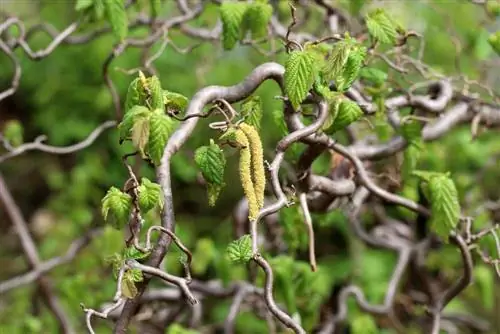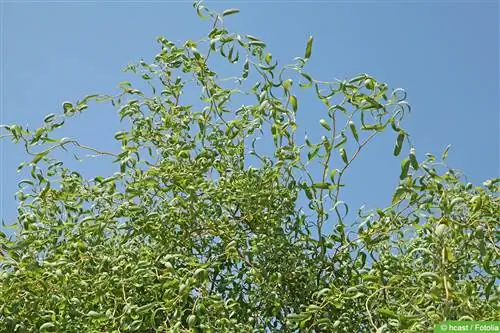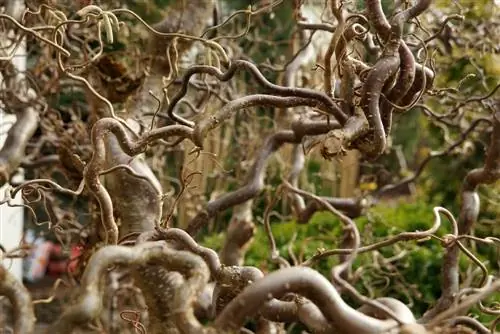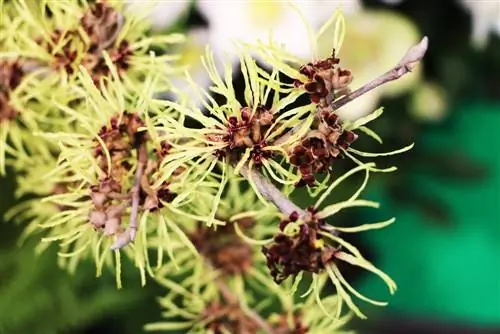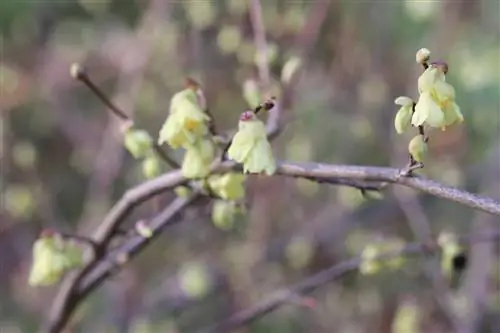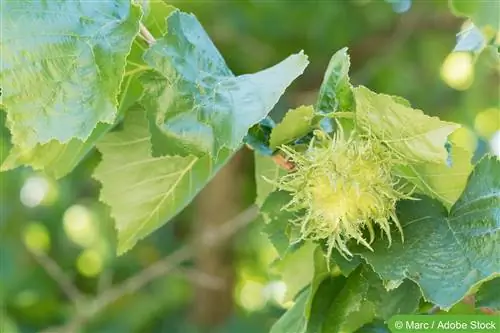- Author admin [email protected].
- Public 2023-12-17 03:39.
- Last modified 2025-06-01 06:48.
The corkscrew hazel develops a bizarre appearance that creates a romantic and mystical atmosphere. This form was probably caused by an illness that has proven to be harmless. Through targeted breeding, it has been preserved to this day and delights garden owners not only with its aesthetics. The corkscrew hazel does not place high demands on care and is considered adaptable and robust.
Profile
- known as 'Contorta'
- Special form of hazel (Corylus avellana)
- Birch family (Betulaceae)
- first discovered in England around 1900
- reaches heights of up to six meters
- bizarre appearance due to winding branches
- Crown broadly spreading in old age with hanging branches
- Flowering period: February to April
- Fruit harvest time: August to September
Location and substrate
The corkscrew hazel is adaptable and feels comfortable in places with sunny to partially shaded and warm conditions. It also thrives in shady locations, although there it shows reduced growth. The substrate should be well-drained, because the shrub will remain in depressed growth on compacted soil that tends to become waterlogged. A fresh, moist to moderately dry and nutrient-rich soil offers ideal growth conditions. The corkscrew hazel prefers a pH value of 7.0. Acidic substrates should be improved with a structurally stable and high-quality plant soil.
Tip:
Plant the shrub as a solitary tree. A location surrounded by air ensures that rain-soaked leaves dry quickly.
Pouring

The need for water decreases with age. Well-established trees have a higher tolerance to dry phases than young plants. In the year of planting, you should water the shrub regularly. Before each watering session, test whether the top layer of substrate has dried thoroughly. Water the plant thoroughly and thoroughly. Excess water should drain well, as corkscrew hazels do not tolerate waterlogging. From the third year onwards, you can slowly stop watering because then the rain will cover the water requirements. You should only water the shrub additionally during long dry periods.
Fertilize
Outdoor trees are fertilized every two to four weeks from the beginning of March. Mature compost or horn shavings are ideal. You can stimulate growth in spring by applying a complex fertilizer and incorporating it into the soil. Continue supplying nutrients with an organic fertilizer until August. Then switch to a potassium fertilizer or comfrey manure so that the shrub can prepare optimally for winter. Fertilization will be completely stopped from September. How to care for corkscrew hazels in pot culture:
- Use liquid fertilizer
- between March and July every two weeks
- then reduce fertilization
- Stop fertilization from August or September
Cutting
Before any cutting measure, the tool should be cleaned thoroughly so that no pathogens accumulate in the cut. Make sure the cutting blades are sharp. Bruises injure the shoots unnecessarily. The cut surfaces should be as angled as possible.
Time
The ideal time for pruning is the low-vegetation period between October and March. During this time the shrub is in the dormant phase. Since the leaves are missing, the sap flow in the branches is interrupted and pruning measures are easier to carry out. Choose an overcast and frost-free day. Intense sunlight can cause the cuts to dry out, causing damage to the shrub.
Note:
A regular cut is not necessary. Bare branches and diseased twigs should still be removed regularly to prevent the crown from thinning out.
Radical cut
Corkscrew hazels tolerate pruning well and can also be radically cut back to the desired size. This is mainly necessary for old trees that are badly out of shape or have grown too tall. As they get older, corkscrew hazels tend to become bald. You can counteract this development by making radical cuts. When shortening, make sure that three to four eyes remain on the branch. The shrub will sprout in these places in the coming growth period.
Blending
So that the crown grows densely and remains aesthetic, you should remove the oldest branches every now and then. Cut two to four branches at the base to make room for fresh spiral shoots. Shoots that have grown too long are shortened by two thirds. If two branches cross each other, one of them should be removed. Branches that grow into the crown or that point steeply upwards are also cut off at the base.
Cut refined variants
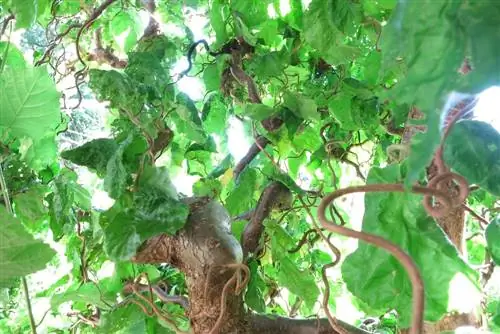
If the corkscrew hazel has been grafted onto the common hazel as a base, you must regularly remove the so-called wild shoots. They shoot from the base of the trunk and grow upright. If the shoots are not cut off, the overall appearance of the corkscrew hazel will be disturbed. Wild shoots should be separated in spring:
- cutting with secateurs
- cut with a spade
- Injuries to the trunk are quickly regenerated
Propagate
Corkscrew hazels are strong growers and can be easily propagated. Both cuttings and sinkers can be used for this.
Cuttings
Unwoody shoots are ideal for propagating cuttings. These grow inside the crown and should have at least four to six leaves. They are cut in the fall so they can take root over the winter. The chance of successful rooting is particularly high if you cut off the shoot below one eye. Remove all but the top pair of leaves and do the following:
- Make peat-sand mixture
- Fill the pot
- Sink the cutting two thirds into the substrate
- Place the container in a warm window seat
- Keep substrate constantly moist
Tip:
Cover the bottom of the pot with a layer of compost and then fill the pot with a nutrient-poor substrate. This promotes root development.
Lowers
Bushy growing shrubs can be propagated with the help of flexible shoots. Pull a branch from the outside of the shrub to the ground and remove the foliage where it touches the ground. The leaves should be retained at the top of the shoot so that the shoot can continue to grow. The following measures are necessary for successful root formation:
- Dig a gutter 10 cm deep
- Dig in the leafless area and weigh it down with stones
- Tie the shoot tip to a wooden stick with a string
- Keep substrate moist
Depending on the weather and location, it can take several months for the sinker to develop roots. When it is strong enough, it is separated from the mother plant and planted in the desired location.
Plants
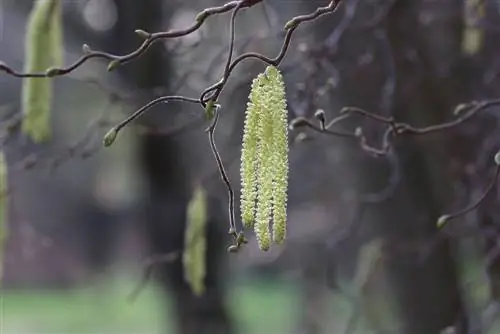
Corkscrew hazels are offered as container products and can be planted all year round. On frosty winter days you should avoid planting in the garden. The optimal planting time is from spring to autumn. If you want to harvest fruit, you should plant two suitable varieties with similar flowering times next to each other. Hazel bushes are not self-pollinators and need a counterpart. How to plant the shrub correctly:
- Water the root ball thoroughly
- Dig a planting pit with twice the volume of the root ball
- Observe a planting distance of 200 cm
- Insert shrub
- Mix the excavated material with compost or horn shavings and fill it into the hole
Press the soil well and water the shrub. To use the water effectively, you can create a watering edge. This slopes towards the base of the trunk and ensures that irrigation and rain water does not run off on the surface.
Repotting
Corkscrew hazels prove to be optimal plants for the bucket. Every two to three years, the shrub is repotted into a larger planter, which is filled with high-quality compost-based potting soil. The minimum volume should be 30 liters. Excess water must be able to escape through a drainage hole so that the roots are not wet. Use a clay pot so that the water balance in the substrate can be optimally regulated.
Always pay attention to a balanced ratio between foliage and roots. If necessary, you can cut back branches or roots.
Wintering
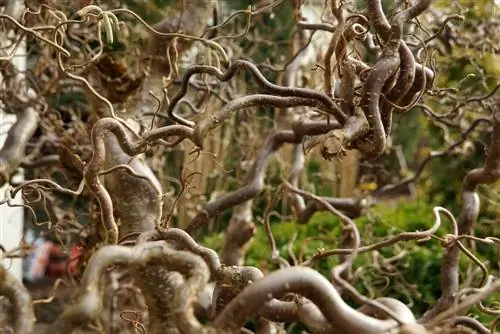
Well-established specimens are hardy and do not require any special protection from frost. Young plants are sensitive to cold air and ground frost. In the first three years, the trees should be provided with winter protection. Wrap the bush with raffia mats or put a jute sack over the branches. Grafted shrubs are protected at the base by piled-up foliage. A mulch layer of brushwood and straw protects the tree disc. Potted plants must be protected from frost even when they are old, as the substrate in the pot freezes quickly:
- Place the bucket on a block of wood
- wrap with foil or jute
- water on frost-free days
- ideally overwinter in a frost-free place
Diseases and pests
He althy plants prove to be robust against pests and diseases. Neglected care or suboptimal site conditions weaken the shrubs, which can occasionally cause problems.
Hazelnut Borer - Curculio nucum
This weevil has specialized in hazelnut plants. Females lay their eggs in hazelnut bushes so that the newly hatched larvae can feed on the nuts. Collect beetles and remove infected fruit. To prevent the spread of pests, the nuts should be burned.
Scalewort - Lathraea squamaria
This parasitic plant settles in over-fertilized soil and deprives the tree of nutrients and water. It has a development period of around ten years, which it spends exclusively in the substrate. During this time it wraps itself around the roots of the host plant. If you discover the plant in the trunk area, you must expose the root ball and remove the parasite plant along with its roots.

